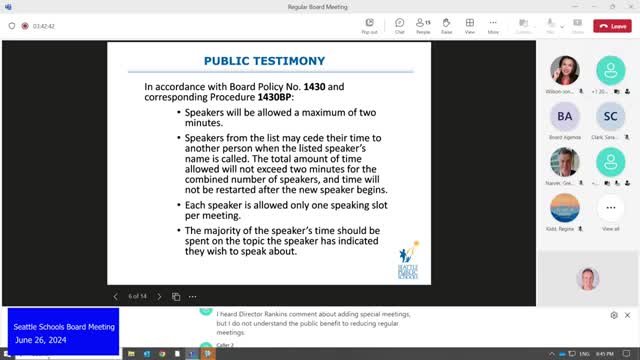Seattle School Board Faces Backlash Over Proposed School Closures
June 27, 2024 | Seattle School District No. 1, School Districts, Washington

This article was created by AI summarizing key points discussed. AI makes mistakes, so for full details and context, please refer to the video of the full meeting. Please report any errors so we can fix them. Report an error »

In a recent Seattle School District board meeting, community members voiced urgent concerns regarding the district's impending fiscal crisis and proposed school closures. The discussions highlighted the need for increased transparency and public engagement as the district navigates a projected $150 million deficit over the next two years.
One speaker emphasized the importance of maintaining regular public comment periods, arguing that these sessions serve as vital platforms for families to address issues such as school safety and staff concerns. The speaker urged the board to hold meetings at least twice a month to ensure adequate oversight during this challenging period.
Concerns about the proposed school closures were echoed by multiple speakers, including parents and former board members. Many argued that closing schools would disproportionately affect vulnerable student populations, particularly those with disabilities, who thrive on stability and consistent routines. One parent shared her experience of her son’s struggles with frequent changes in special education staff, emphasizing the need for continuity in education.
Critics of the closure plan also questioned the district's financial projections, suggesting that anticipated savings from closing schools may not materialize as expected. They called for a more comprehensive approach to addressing budget gaps, including exploring alternative funding sources and engaging the community in decision-making processes.
Several speakers highlighted the lack of transparency in the district's planning, comparing it unfavorably to other districts like San Francisco, which has actively engaged the community in discussions about school closures. They urged the Seattle School Board to adopt similar practices to foster trust and collaboration with families.
As the district grapples with these significant challenges, the call for a more inclusive and transparent approach to decision-making remains a central theme among community members, who are eager to ensure that the needs of all students are prioritized in the face of budgetary constraints.
One speaker emphasized the importance of maintaining regular public comment periods, arguing that these sessions serve as vital platforms for families to address issues such as school safety and staff concerns. The speaker urged the board to hold meetings at least twice a month to ensure adequate oversight during this challenging period.
Concerns about the proposed school closures were echoed by multiple speakers, including parents and former board members. Many argued that closing schools would disproportionately affect vulnerable student populations, particularly those with disabilities, who thrive on stability and consistent routines. One parent shared her experience of her son’s struggles with frequent changes in special education staff, emphasizing the need for continuity in education.
Critics of the closure plan also questioned the district's financial projections, suggesting that anticipated savings from closing schools may not materialize as expected. They called for a more comprehensive approach to addressing budget gaps, including exploring alternative funding sources and engaging the community in decision-making processes.
Several speakers highlighted the lack of transparency in the district's planning, comparing it unfavorably to other districts like San Francisco, which has actively engaged the community in discussions about school closures. They urged the Seattle School Board to adopt similar practices to foster trust and collaboration with families.
As the district grapples with these significant challenges, the call for a more inclusive and transparent approach to decision-making remains a central theme among community members, who are eager to ensure that the needs of all students are prioritized in the face of budgetary constraints.
View full meeting
This article is based on a recent meeting—watch the full video and explore the complete transcript for deeper insights into the discussion.
View full meeting
